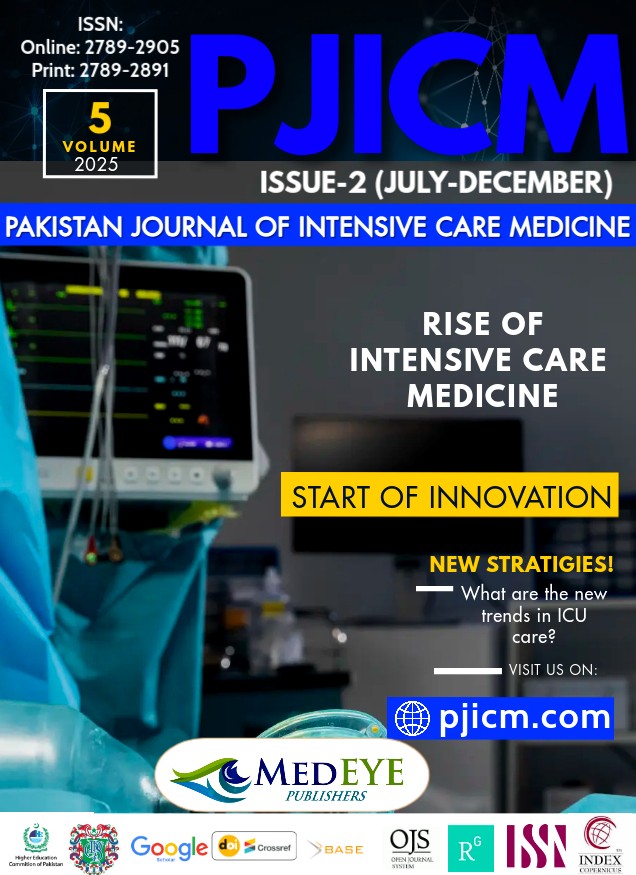COMPARISON OF SPOTTY CALCIFICATIONS ON CERVICO-CEREBRAL COMPUTED TOMOGRAPHY ANGIOGRAPHY IN PATIENTS WITH AND WITHOUT ISCHEMIC STROKE
DOI:
https://doi.org/10.54112/pjicm.v5i02.191Keywords:
Keywords: Ischemic Stroke; Computed Tomography Angiography; Spotty Calcifications; Carotid Atherosclerosis; Vascular ImagingAbstract
Background: Ischemic stroke is a major global cause of morbidity and mortality. Cervico-cerebral computed tomography angiography (CTA) allows early visualization of vascular changes, such as spotty calcifications and small, focal calcium deposits within arterial walls, considered indicators of plaque vulnerability and stroke risk. Objective: To compare the mean number and distribution of spotty calcifications on CTA among patients with ischemic stroke and those without stroke but with carotid atherosclerosis in the Pakistani population. Study Design: Case–control study. Setting: Department of Diagnostic Radiology, Chaudhry Pervaiz Elahi Institute of Cardiology (CPEIC), Multan, Pakistan. Duration of Study: January to December 2024. Methods: Sixty participants aged 40–65 years were enrolled, including 30 patients with confirmed ischemic stroke (cases) and 30 age- and sex-matched controls with carotid atherosclerosis but no prior stroke. Cervico-cerebral CTA was performed using a 256-slice multidetector scanner. Spotty calcifications were defined as calcified plaques <3 mm in length and <90° arc with attenuation ≥130 Hounsfield Units. The number and vascular distribution of calcifications were assessed and compared using an independent-samples t-test. Data analysis was conducted in SPSS version 25, with a p-value ≤ 0.05 considered statistically significant. Results: The mean age of participants was 56.8 ± 6.9 years, with males comprising 63.3%. The mean number of spotty calcifications was significantly higher in ischemic stroke patients (6.9 ± 4.2) than in controls (3.0 ± 2.8; p < 0.001). The carotid bifurcation was the most frequent site of calcification, followed by the carotid siphon and middle cerebral artery (MCA) segments. Stroke patients showed significantly higher calcification counts in LMCA1, RMCA1, and the basilar artery (p < 0.05). Subgroup analysis revealed a higher calcification burden in stroke patients with diabetes mellitus (p = 0.002), hypertension (p = 0.003), and smoking history (p = 0.004). Conclusion: Spotty calcifications are significantly more prevalent and widely distributed in patients with ischemic stroke compared to those without stroke, particularly at the carotid bifurcation and MCA segments. Their strong association with diabetes, hypertension, and smoking suggests that spotty calcifications on CTA may serve as early imaging biomarkers for stroke risk, aiding in timely prevention and intervention strategies in the Pakistani population.
References
Liu B., Chen X., Lu H., Wang C., Duan S., & Yang H. Ct texture analysis of vertebrobasilar artery calcification to identify culprit plaques. Frontiers in Neurology 2024;15. https://doi.org/10.3389/fneur.2024.1381370
Homssi M., Vora A., Zhang C., Baradaran H., Kamel H., & Gupta A. Association between spotty calcification in nonstenosing extracranial carotid artery plaque and ipsilateral ischemic stroke. Journal of the American Heart Association 2023;12(10). https://doi.org/10.1161/jaha.122.028525
Li X., Du H., Li J., & Chen X.. Intracranial artery calcification as an independent predictor of ischemic stroke: a systematic review and a meta-analysis. BMC Neurology 2023;23(1). https://doi.org/10.1186/s12883-023-03069-x
Pakizer D., Šalounová D., & Školoudík D. Extracranial carotid plaque calcification and its association with risk factors for cerebrovascular events: insights from the antique study. Frontiers in Neurology 2025;16. https://doi.org/10.3389/fneur.2025.1532883
Zheng C., Yan S., Fu F., Zhao C., Guo D., Wang Z.et al.. Cervicocephalic spotty calcium for the prediction of coronary atherosclerosis in patients with acute ischemic stroke. Frontiers in Neurology 2021;12. https://doi.org/10.3389/fneur.2021.659156
Yang H., Liu B., Yin Q., Zhang S., Shen Y., Ji C., et al Comparison of symptomatic vertebrobasilar plaques between patients with and without diabetes mellitus using computed tomographic angiography and vessel wall magnetic resonance imaging. Diabetes and Vascular Disease Research 2022;19(1). https://doi.org/10.1177/14791641211073944
Homssi M., Vora A., Zhang C., Baradaran H., Kamel H., & Gupta A. Association between spotty calcification in nonstenosing extracranial carotid artery plaque and ipsilateral ischemic stroke. Journal of the American Heart Association 2023;12(10). https://doi.org/10.1161/jaha.122.028525
Xue P., Lin L., Li P., Deng Z., Chen X., & Zhuang Y.. Development and validation of nomograms for predicting coronary artery calcification and severe coronary artery calcification: a retrospective cross-sectional study. 2024. https://doi.org/10.1101/2024.09.12.24313598
Pakizer D., Šalounová D., & Školoudík D. Extracranial carotid plaque calcification and its association with risk factors for cerebrovascular events: insights from the antique study. Frontiers in Neurology 2025;16. https://doi.org/10.3389/fneur.2025.1532883
Jeon S., Park H., Kwak H., & Hwang S.. Findings of angiography and carotid vessel wall imaging associated with post-procedural clinical events after carotid artery stenting. Neurointervention 2024;19(1):14-23. https://doi.org/10.5469/neuroint.2023.00486
Homssi M., Saha A., Delgado D., RoyChoudhury A., Thomas C., Lin M.et al.. Extracranial carotid plaque calcification and cerebrovascular ischemia: a systematic review and meta-analysis. Stroke 2023;54(10):2621-2628. https://doi.org/10.1161/strokeaha.123.042807
Lee P., Huang M., Huang T., Hsu C., Lin S., & Liu P. High burden of premature ventricular complexes increases the risk of new‐onset atrial fibrillation. Journal of the American Heart Association 2023;12(4). https://doi.org/10.1161/jaha.122.027674
Downloads
Published
How to Cite
Issue
Section
License
Copyright (c) 2025 A RAZZAQ , N PASHA , Z SADIQ , R FATIMA , MAA JAVAID

This work is licensed under a Creative Commons Attribution-NonCommercial 4.0 International License.












